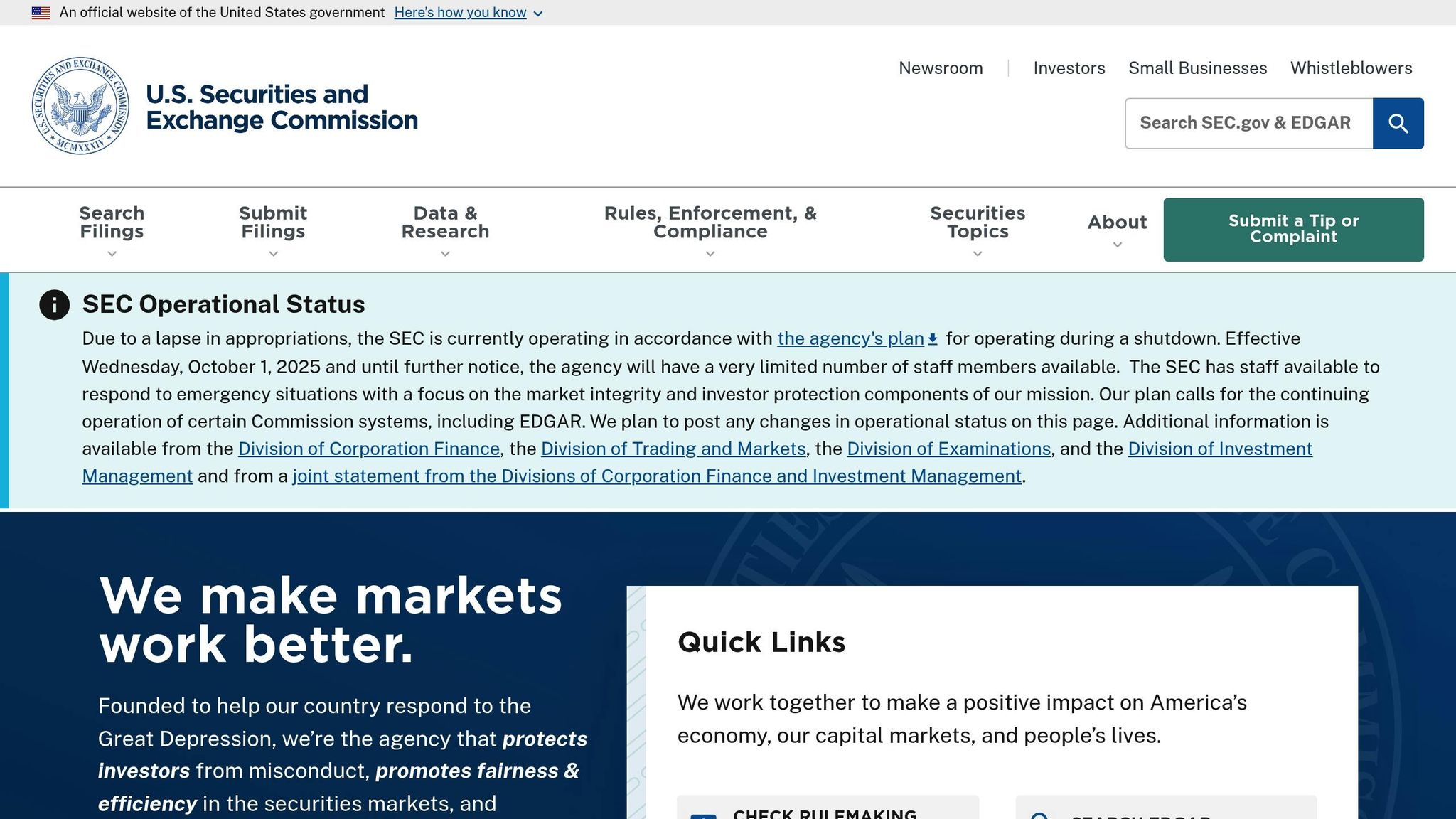Raising funds internationally as a startup? Here's the deal: You can't just follow your home country's rules. Multinational securities laws require compliance with regulations in every country where you operate, employ staff, or attract investors. For example, a U.S. startup raising money in Canada and the UK must meet SEC rules, Canadian securities laws, and UK financial regulations - all at once.
Why does this matter?
Non-compliance can lead to fines, lawsuits, investor rescission (investors demanding their money back), and even being barred from future fundraising. For startups aiming to grow globally or go public, compliance isn't optional - it's essential for building trust and avoiding costly mistakes.
The challenge?
Startups face a maze of overlapping rules that differ by jurisdiction. Limited resources, rapid growth, and changing regulations make staying compliant tough. But with proper planning, tools, and expert help, startups can navigate these laws effectively.
Key takeaways:
- Map jurisdictions: Identify where your business operates, employs staff, or targets investors.
- Understand filings: Meet all local filing deadlines (e.g., SEC Form D in the U.S. within 15 days of securities sales).
- Track compliance: Use tools like compliance matrices and software to manage deadlines and documentation.
- Build a team: Combine in-house efforts with external experts for specialized needs.
- Leverage tech: Platforms can automate tasks like cap table updates, filings, and deadline tracking.
- Audit regularly: Internal and external audits catch errors and keep you ahead of regulatory changes.
Bottom line: Multinational compliance is complex but manageable. Treat it as an ongoing priority, not a one-time task, and you'll set your startup up for global success.
Exemptions to SEC Registration: Raising Funds Without Public Offering Costs

How to Identify Global Compliance Requirements
Figuring out global compliance requirements starts with identifying every jurisdiction where your startup operates and understanding what activities trigger compliance. This isn’t just about where your business is incorporated - it’s about pinpointing every location where you conduct business, employ staff, or plan to attract investors.
Map Your Operating Jurisdictions and Business Activities
Begin by analyzing your current and planned business operations. This means identifying where your company is incorporated, where it operates, and where it targets customers or investors. For instance, a startup incorporated in Delaware but operating in both the U.S. and Europe must navigate U.S. federal and state securities laws alongside applicable EU regulations. Managing compliance across these frameworks requires careful planning.
Document every jurisdiction where you have operations, employees, or customers. Don’t forget indirect activities like cross-border online sales or employing remote workers in different regions.
Next, track your fundraising efforts, equity issuances, and other securities-related transactions. Each jurisdiction has specific filing requirements, and missing these can lead to penalties or even the reversal of funds raised.
Common mistakes include overlooking state-level rules like U.S. "blue sky" laws, missing filing deadlines, or assuming compliance in one country covers all jurisdictions. These errors can lead to serious consequences, so thorough research is critical.
After mapping your activities, focus on understanding your company’s structure to address varying regulatory obligations.
Understand Holding vs. Operating Entities
It’s important to distinguish between holding companies and operating entities, as they often face different compliance requirements. A holding company typically owns shares in subsidiaries, while operating entities handle daily business operations and interact with customers or investors.
For example, if you have a U.S.-based holding company with a U.K. operating subsidiary, each entity must meet its local compliance obligations. The holding company might focus on ownership reporting and tax structuring, while the operating entity will handle local filings and compliance with consumer laws.
| Entity Type | Typical Compliance Focus | Example Obligations |
|---|---|---|
| Holding Company | Ownership, reporting, tax | Parent-level filings, beneficial ownership |
| Operating Entity | Day-to-day operations, local laws | Local securities filings, consumer laws |
Understanding these distinctions helps you build a compliance framework tailored to your business structure.
Create a Compliance Requirements Matrix
A compliance requirements matrix is a powerful tool for managing overlapping obligations across jurisdictions. This table should track all relevant regulations, filing deadlines, and responsibilities for every jurisdiction where your business operates.
Include columns for jurisdiction, specific regulations, filing requirements, deadlines, responsible team members, and completion status. For example, your matrix could include Form D filings for U.S. fundraising, Form 5471 for foreign subsidiaries, and local prospectus requirements for EU markets.
As your business evolves, update the matrix regularly. Entering new markets or starting new funding rounds means new compliance obligations, and staying on top of these prevents missed deadlines or overlooked filings.
Technology can simplify this process. Tools like Lucid Financials can automate bookkeeping, track deadlines, and generate investor-ready reports. These platforms reduce manual errors and ensure you stay on top of compliance while focusing on scaling your business. Real-time reporting features also keep your documentation up-to-date as you expand into new markets.
Although building a compliance matrix takes effort upfront, it’s worth it. It helps you avoid costly mistakes, keeps your team organized, and ensures your startup is prepared to navigate the complexities of global compliance as you grow. Regular reviews and updates will keep your business ahead of regulatory changes and new market demands.
Required Documentation and Filings for Cross-Border Fundraising
When navigating cross-border fundraising, it's critical to align all documentation and filings with the legal requirements of each jurisdiction involved. Mistakes in this area can lead to hefty fines, investor rescission, or even disqualification from future fundraising opportunities. Below, we’ll break down the essential documents, filings, and record-keeping practices to help ensure compliance across borders.
Essential Documents for Securities Compliance
For startups raising funds internationally, assembling the right compliance documents is non-negotiable. These documents not only satisfy legal requirements but also safeguard your business and investors.
The Private Placement Memorandum (PPM) is the cornerstone of your offering. This document lays out the investment terms, outlines business risks, and includes financial projections. It must present an honest and thorough picture of your business while clearly explaining any risks that could impact investor returns.
Subscription Agreements are equally vital. These contracts formalize the relationship between your startup and each investor, specifying details like investment amounts, share classes, transfer restrictions, and investor representations. Different jurisdictions often have unique legal requirements, so you may need to tailor these agreements for each market.
Investor Accreditation Questionnaires are another key piece. They verify whether investors meet local exemption criteria, which can vary widely depending on the jurisdiction. To stay compliant, these questionnaires must be customized to capture the specific information required in each market.
Other important documents might include term sheets summarizing deal terms, shareholder agreements that define investor rights, and disclosure statements addressing region-specific requirements. The exact documentation you'll need depends on factors like your incorporation location, operational footprint, and where your investors are based.
Critical Regulatory Filings and Deadlines
Meeting filing deadlines is just as important as having the right documents. Missing a deadline can lead to penalties or even give investors the right to rescind their investments.
In the United States, startups using Regulation D exemptions must file Form D with the SEC within 15 days of their first securities sale. While it may seem straightforward, missing this filing can result in civil penalties and allow investors to demand their money back - plus interest.
State-level "blue sky" filings add another layer of complexity. Each state where you have investors may require its own notice filings, often with deadlines that are as tight - or tighter - than federal ones. Ignoring these filings can lead to enforcement actions that disrupt your fundraising efforts.
For startups with international subsidiaries, IRS filings become equally critical. U.S. companies owning at least 10% of a foreign corporation must file Form 5471, while those with 25% or more foreign ownership or reportable transactions must submit Form 5472. The penalties for late or incomplete filings are steep - $10,000 per form, per year.
| Filing Type | Deadline | Penalty |
|---|---|---|
| Form D (SEC) | 15 days after first sale | Civil penalties, investor rescission rights |
| State Blue Sky Filings | Varies by state | Enforcement actions, fundraising disruption |
| Form 5471 (IRS) | With tax return | $10,000 per form, per year |
| Form 5472 (IRS) | With tax return | $10,000 per form, per year |
To stay on top of these deadlines, consider setting up calendar reminders or using compliance tracking systems. Partnering with experts or leveraging compliance software can also help you manage deadlines and avoid costly errors.
Synchronizing Documentation with Cap Tables
While meeting filing deadlines is crucial, maintaining accurate records is just as important for ensuring compliance and audit readiness. A well-maintained cap table is a must - it should reflect every securities issuance, transfer, and ownership change in real time. Any mismatch between your cap table and legal documents can cause major headaches during audits or future fundraising rounds.
Centralizing your cap table management can help keep everything in sync. By using a system that updates in real time, you can ensure transparency, meet regulatory requirements, and keep your filings accurate. Regularly reconciling your legal documents with your cap table will prevent errors from piling up.
Platforms like Lucid Financials can simplify this process. Their AI-powered tools integrate with systems like Slack to provide real-time updates and investor-ready reporting. These platforms can streamline compliance for startups operating in multiple jurisdictions by automating document management, tracking filing deadlines, and keeping records accurate.
Technology like this minimizes manual errors and lets you focus on growing your business. Features like automated reminders and real-time reporting ensure your documentation stays current as you expand into new markets. Plus, regular audits can catch and resolve small issues before they grow into bigger problems.
sbb-itb-17e8ec9
How to Build a Multinational Compliance Strategy
Once you've sorted out your documentation and filings, the next step is to craft a multinational compliance strategy that not only safeguards your startup but also supports its growth across borders. This isn’t just about ticking boxes - it's about creating a system that keeps you ahead of changing regulations while empowering your business to thrive. To achieve this, you’ll need the right mix of people, technology, and processes.
Build a Compliance Team or Partner with Experts
The first decision is whether to build an in-house compliance team or work with external experts. Your choice will depend on your resources, expertise, and budget.
An in-house team gives you full control and ensures a dedicated focus on your company’s unique needs. However, it demands significant investment in hiring, training, and staying updated on regulations across different countries. On the other hand, external experts bring specialized knowledge, which can help you avoid costly mistakes - especially if you’re a startup navigating unfamiliar regulatory landscapes.
For example, Lucid Financials offers AI-driven compliance monitoring with flat-rate pricing starting at $150 per month, making it an attractive option for early-stage companies.
Many startups find that a hybrid approach works best. A small internal team can handle day-to-day compliance tasks, while external experts step in for more complex, specialized needs. Once your team is established, the next step is to integrate technology to simplify and enhance your compliance processes.
Use Technology for Compliance Management
Technology can transform compliance from a manual, error-prone process into a streamlined, scalable system. AI-driven platforms can track regulatory changes, automate reporting, and update filings in real time, reducing the risk of human error.
Modern compliance tools often integrate seamlessly with the software you already use. For instance, Lucid Financials connects directly with Slack, enabling founders to ask compliance-related questions and receive instant, AI-powered answers. Whether you’re checking deadlines or analyzing your financial runway, these tools ensure you’re always on top of what needs attention.
Another major advantage of these systems is their ability to synchronize records. As your cap table evolves - whether through new investors or equity adjustments - these platforms automatically update related documentation and filings. This not only reduces manual errors but also simplifies the audit process.
Conduct Regular Audits and Risk Management
Even with a skilled team and advanced technology, regular audits and risk assessments are essential for a solid compliance strategy.
Internal audits, conducted quarterly or on a similar schedule, help identify gaps before they become costly issues. These audits should review your policies, procedures, and financial records to ensure everything aligns with your compliance framework. They’re also a good opportunity to confirm that filings are up to date and that your documentation matches your cap table.
External audits, performed by third-party professionals, offer an independent review of your financial statements and regulatory adherence. These annual reviews are especially helpful when preparing for fundraising, as they demonstrate to investors that your compliance processes are well-managed.
In addition to audits, regular risk assessments are crucial. These evaluations consider how changes - such as entering new markets or restructuring investor agreements - might affect your compliance obligations. Documenting the findings and any corrective actions not only keeps you prepared but also serves as evidence of your proactive approach if regulators come knocking.
Securities Regulations Across Major Jurisdictions
For startups raising capital internationally, understanding securities regulations in each major market is crucial. Every jurisdiction has its own unique set of rules, creating a maze of compliance requirements that can influence your fundraising approach and ongoing obligations. Let’s break down how these regulations differ across key regions.
In the United States, securities regulation operates on two levels: federal and state. The Securities and Exchange Commission (SEC) enforces federal laws like the Securities Act of 1933 and the Securities Exchange Act of 1934. At the state level, "blue sky" laws add another layer of oversight. This dual system requires startups to meet both federal and state-specific requirements, making compliance particularly intricate.
The European Union offers a more unified approach, thanks to its passporting system under MiFID II and the Prospectus Regulation. This allows startups to access multiple EU markets with a single approval. However, local variations still exist, as individual member states can impose additional requirements. While the EU framework simplifies cross-border operations compared to the U.S., startups must still navigate country-specific rules and enforcement practices across more than 30 member states.
In the Asia-Pacific, securities regulations are highly fragmented. Countries like Singapore, Hong Kong, and Australia each have their own rules, which are evolving rapidly as governments compete to attract fintech startups and foreign investors. The lack of regional coordination, however, means compliance requirements can differ significantly even between neighboring countries. This regulatory patchwork complicates fundraising and increases compliance costs for startups operating in the region.
U.S. startups often rely on Regulation D exemptions, which require strict adherence to compliance rules. In contrast, EU startups make use of the passporting system to raise capital across member states, though they must contend with varying disclosure requirements. In Asia-Pacific, private placement exemptions are common, but the specifics vary widely by country, adding another layer of complexity.
Penalties for non-compliance also reflect each region’s regulatory philosophy. In the U.S., penalties are particularly severe, with "bad actor" disqualifications that can permanently restrict access to certain exemptions. The EU leans more toward administrative fines and investor compensation, while Asia-Pacific penalties range from fines to operational restrictions, depending on the country.
Key Differences Between Jurisdictions
Here’s a snapshot of how securities regulations differ across the U.S., EU, and Asia-Pacific:
| Aspect | United States | European Union | Asia-Pacific |
|---|---|---|---|
| Primary Regulators | SEC, State Regulators | ESMA, Local Authorities | MAS (Singapore), SFC (Hong Kong), ASIC (Australia) |
| Key Regulations | Securities Act 1933, Exchange Act 1934, State Blue Sky Laws | MiFID II, Prospectus Regulation, Local Member State Laws | Securities and Futures Act (SG), Securities and Futures Ordinance (HK), Corporations Act 2001 (AU) |
| Common Exemptions | Regulation D (506(b), 506(c)), Regulation A, Rule 701 | Private Placement Exemptions, Small Offering Exemptions | Private Placement to Accredited Investors, Local Exemptions |
| Filing Requirements | Form D, State Filings, IRS Forms | Prospectus (above thresholds), Local Notifications | Local Registration, AML/KYC Documentation |
| Investor Qualification | Accredited Investor ($1M+ net worth or $200K+ income), Qualified Institutional Buyer | Professional Investor, Qualified Investor (varies by state) | Accredited Investor (varies by country), Institutional Investor |
| Disclosure Obligations | Private Placement Memorandum, Financial Statements | Prospectus or Offering Document, Risk Disclosures | Offering Memorandum, Financial Reports |
| Penalties for Non-Compliance | Civil fines up to $10,000+ per violation, Rescission, Bad Actor Disqualification | Administrative fines, Criminal sanctions, Investor compensation | Fines, Criminal prosecution, Business restrictions |
| Challenges | Dual federal/state compliance, Complex exemption requirements, Severe penalties | Passporting complexities, Local variations, GDPR compliance | Fragmented rules, Frequent regulatory updates, Language barriers |
The financial and operational impact of these regulatory differences can be substantial. Leveraging integrated compliance platforms can help streamline filings and monitor requirements in real time across jurisdictions.
How to Navigate Multinational Securities Laws Successfully
Managing compliance across multiple jurisdictions can feel like walking a tightrope, but a solid framework can help you avoid stumbles that could hinder growth. By building on your current compliance strategy, you can take practical steps that blend thoughtful planning, smart technology, and expert advice.
Think of compliance not as a one-off legal task but as an ongoing part of your business operations. The stakes are high - recent enforcement actions by the SEC highlight the risks of non-compliance, including hefty fines, rescinded investments, and disqualification from future fundraising exemptions. These penalties can do serious damage to both a startup’s growth trajectory and its reputation. Keeping compliance aligned with your evolving business is essential.
Tools like Lucid Financials, powered by AI, can simplify multinational compliance. These platforms automate tasks like bookkeeping, regulatory deadline tracking, and creating investor-ready reports. They also integrate seamlessly into your daily operations through tools like Slack, offering real-time updates, automated reminders, and synchronized cap tables with regulatory filings. This not only minimizes compliance missteps but also reduces the risk of manual errors.
To make compliance part of your day-to-day workflow, establish clear policies, provide ongoing training, and use adaptive monitoring systems. Keep detailed records of all compliance activities and decisions to show your commitment to meeting regulatory requirements during audits or reviews.
Next Steps for Compliance Success
Technology plays a critical role in tackling compliance challenges, but it’s not the whole story. Combine it with expert guidance, whether from an internal compliance team or external specialists who understand the complexities of cross-border securities laws.
Stay informed about regulatory changes by subscribing to updates, attending webinars, and working closely with legal professionals who specialize in securities law. Regulations are always shifting, and what worked during your Series A fundraising might not apply when you’re expanding into new markets for Series B. AI-driven tools can help here, offering automated updates on new rules so you can adjust your strategy without missing a beat.
Regular compliance audits are another must. Use them to refine your policies, align with your growing operations, and ensure you’re staying ahead of regulatory changes. Investing in a strong compliance system pays off, especially during fundraising, partnership negotiations, or when preparing for an acquisition or exit.
Ultimately, compliance isn’t just about sidestepping penalties. It’s a way to build trust with investors, open doors to new markets, and create opportunities for sustainable growth. A well-structured compliance approach can accelerate fundraising, support confident expansion, and let you focus on developing your business.
FAQs
What mistakes do startups often make with multinational securities laws, and how can they avoid them?
Startups often struggle with navigating multinational securities laws, which can be tricky due to their complexity and the differences in requirements from one country to another. Common missteps include failing to properly register securities, neglecting disclosure obligations, or misinterpreting exemptions. These mistakes can lead to serious consequences like legal fines, disputes with investors, and damage to a company's reputation.
To steer clear of these issues, startups should prioritize getting expert advice early on, conduct thorough research on the regulations in every country where they operate, and stay diligent about meeting all filing and reporting requirements. Using tools like Lucid Financials, which provides real-time financial insights and investor-ready reporting, can also be a valuable way to manage compliance while keeping the focus on scaling the business.
How can startups use AI-driven tools to simplify compliance with multinational securities laws?
AI-powered platforms simplify compliance management for startups operating in multiple jurisdictions by automating complex tasks and ensuring precision. These tools can interpret regulations, monitor financial activities, and produce reports that align with legal requirements - saving both time and minimizing the risk of mistakes.
For startups, this translates to maintaining compliance without the burden of constant manual monitoring. With these intelligent systems handling the finer details, founders can dedicate their energy to scaling their business while trusting the accuracy and reliability of AI-driven compliance solutions.
How do securities regulations differ across the U.S., EU, and Asia-Pacific, and what should startups know to stay compliant?
Understanding securities regulations across regions like the U.S., EU, and Asia-Pacific is crucial for startups planning international expansion. Each region has its own approach to oversight, which means businesses must adapt accordingly.
In the U.S., laws such as the Securities Act of 1933 and the SEC’s oversight focus heavily on protecting investors. This involves detailed disclosure requirements and strict compliance measures to ensure transparency. Meanwhile, the EU prioritizes harmonization and transparency among its member states. Frameworks like MiFID II set standards for financial markets and investor protections, creating a more unified regulatory environment. Over in the Asia-Pacific, the landscape is more fragmented. Countries like Japan and Singapore have developed their own distinct regulatory systems to suit their individual markets.
For startups, navigating these differences requires a region-specific compliance strategy. This might involve customizing disclosures, understanding how enforcement works locally, and working with experts who know the laws inside out. Leveraging tools like AI-powered accounting platforms can also streamline compliance efforts, helping ensure financial reporting meets the unique requirements of each jurisdiction.


